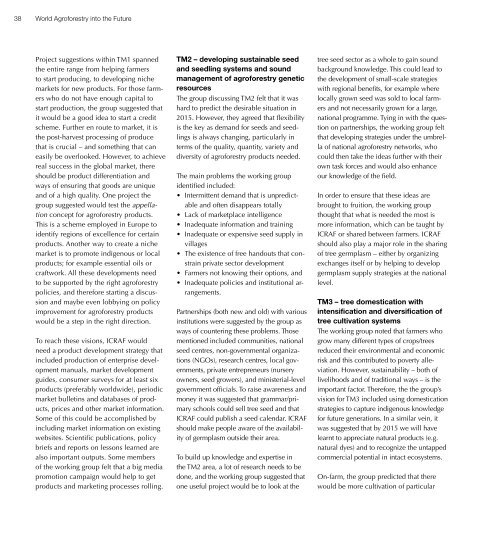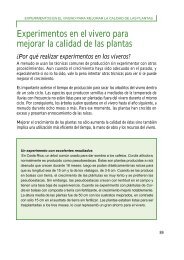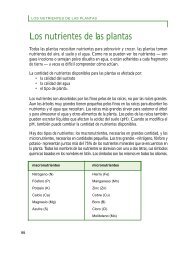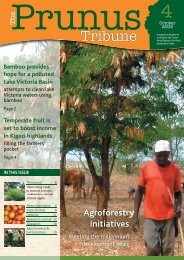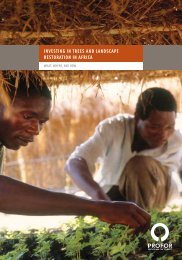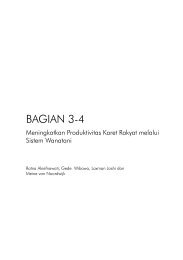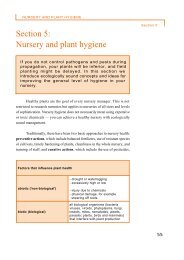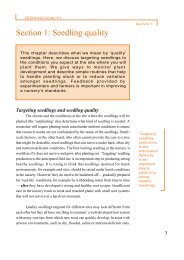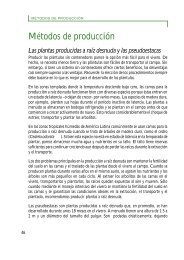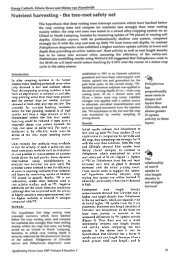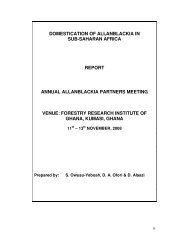Download as a PDF - World Agroforestry Centre
Download as a PDF - World Agroforestry Centre
Download as a PDF - World Agroforestry Centre
You also want an ePaper? Increase the reach of your titles
YUMPU automatically turns print PDFs into web optimized ePapers that Google loves.
38<br />
<strong>World</strong> <strong>Agroforestry</strong> into the Future<br />
Project suggestions within TM1 spanned<br />
the entire range from helping farmers<br />
to start producing, to developing niche<br />
markets for new products. For those farmers<br />
who do not have enough capital to<br />
start production, the group suggested that<br />
it would be a good idea to start a credit<br />
scheme. Further en route to market, it is<br />
the post-harvest processing of produce<br />
that is crucial – and something that can<br />
e<strong>as</strong>ily be overlooked. However, to achieve<br />
real success in the global market, there<br />
should be product differentiation and<br />
ways of ensuring that goods are unique<br />
and of a high quality. One project the<br />
group suggested would test the appellation<br />
concept for agroforestry products.<br />
This is a scheme employed in Europe to<br />
identify regions of excellence for certain<br />
products. Another way to create a niche<br />
market is to promote indigenous or local<br />
products; for example essential oils or<br />
craftwork. All these developments need<br />
to be supported by the right agroforestry<br />
policies, and therefore starting a discussion<br />
and maybe even lobbying on policy<br />
improvement for agroforestry products<br />
would be a step in the right direction.<br />
To reach these visions, ICRAF would<br />
need a product development strategy that<br />
included production of enterprise development<br />
manuals, market development<br />
guides, consumer surveys for at le<strong>as</strong>t six<br />
products (preferably worldwide), periodic<br />
market bulletins and datab<strong>as</strong>es of products,<br />
prices and other market information.<br />
Some of this could be accomplished by<br />
including market information on existing<br />
websites. Scientific publications, policy<br />
briefs and reports on lessons learned are<br />
also important outputs. Some members<br />
of the working group felt that a big media<br />
promotion campaign would help to get<br />
products and marketing processes rolling.<br />
TM2 – developing sustainable seed<br />
and seedling systems and sound<br />
management of agroforestry genetic<br />
resources<br />
The group discussing TM2 felt that it w<strong>as</strong><br />
hard to predict the desirable situation in<br />
2015. However, they agreed that flexibility<br />
is the key <strong>as</strong> demand for seeds and seedlings<br />
is always changing, particularly in<br />
terms of the quality, quantity, variety and<br />
diversity of agroforestry products needed.<br />
The main problems the working group<br />
identified included:<br />
• Intermittent demand that is unpredictable<br />
and often disappears totally<br />
• Lack of marketplace intelligence<br />
• Inadequate information and training<br />
• Inadequate or expensive seed supply in<br />
villages<br />
• The existence of free handouts that constrain<br />
private sector development<br />
• Farmers not knowing their options, and<br />
• Inadequate policies and institutional arrangements.<br />
Partnerships (both new and old) with various<br />
institutions were suggested by the group <strong>as</strong><br />
ways of countering these problems. Those<br />
mentioned included communities, national<br />
seed centres, non-governmental organizations<br />
(NGOs), research centres, local governments,<br />
private entrepreneurs (nursery<br />
owners, seed growers), and ministerial-level<br />
government officials. To raise awareness and<br />
money it w<strong>as</strong> suggested that grammar/primary<br />
schools could sell tree seed and that<br />
ICRAF could publish a seed calendar. ICRAF<br />
should make people aware of the availability<br />
of germpl<strong>as</strong>m outside their area.<br />
To build up knowledge and expertise in<br />
the TM2 area, a lot of research needs to be<br />
done, and the working group suggested that<br />
one useful project would be to look at the<br />
tree seed sector <strong>as</strong> a whole to gain sound<br />
background knowledge. This could lead to<br />
the development of small-scale strategies<br />
with regional benefits, for example where<br />
locally grown seed w<strong>as</strong> sold to local farmers<br />
and not necessarily grown for a large,<br />
national programme. Tying in with the question<br />
on partnerships, the working group felt<br />
that developing strategies under the umbrella<br />
of national agroforestry networks, who<br />
could then take the ide<strong>as</strong> further with their<br />
own t<strong>as</strong>k forces and would also enhance<br />
our knowledge of the field.<br />
In order to ensure that these ide<strong>as</strong> are<br />
brought to fruition, the working group<br />
thought that what is needed the most is<br />
more information, which can be taught by<br />
ICRAF or shared between farmers. ICRAF<br />
should also play a major role in the sharing<br />
of tree germpl<strong>as</strong>m – either by organizing<br />
exchanges itself or by helping to develop<br />
germpl<strong>as</strong>m supply strategies at the national<br />
level.<br />
TM3 – tree domestication with<br />
intensification and diversification of<br />
tree cultivation systems<br />
The working group noted that farmers who<br />
grow many different types of crops/trees<br />
reduced their environmental and economic<br />
risk and this contributed to poverty alleviation.<br />
However, sustainability – both of<br />
livelihoods and of traditional ways – is the<br />
important factor. Therefore, the the group’s<br />
vision for TM3 included using domestication<br />
strategies to capture indigenous knowledge<br />
for future generations. In a similar vein, it<br />
w<strong>as</strong> suggested that by 2015 we will have<br />
learnt to appreciate natural products (e.g.<br />
natural dyes) and to recognize the untapped<br />
commercial potential in intact ecosystems.<br />
On-farm, the group predicted that there<br />
would be more cultivation of particular


